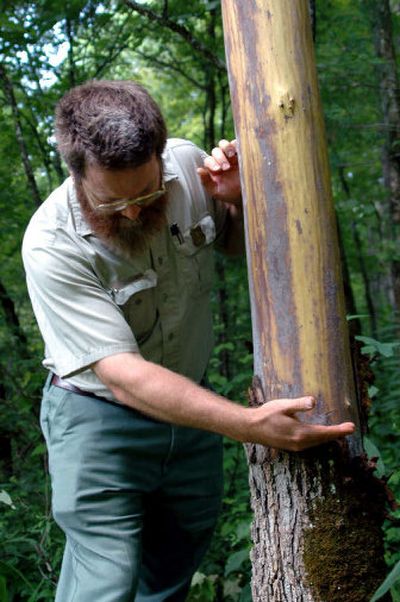Now the trees need a remedy

DANIEL BOONE NATIONAL FOREST, Ky. — The 20-foot tree stands half naked, much of the bark stripped from its trunk. It has only months to live.
“It doesn’t know it’s dead,” says U.S. Forest Service botanist David Taylor, pointing to the healthy leaves overhead.
This slippery elm has fallen victim to thieves who tore off its bark for profit in the lucrative and burgeoning herbal-remedy market.
The gummy lining of the bark has long been used in North America, and especially Appalachia, as a soothing agent for coughs, gastrointestinal ailments and skin irritations. But now, slippery elm and other herbal products that were once used seasonally by locals are in demand by millions.
“I think that trend is going to put pressure on limited resources such as the slippery elm,” said Dr. Michael Hirt, founding director for the Center for Integrative Medicine in Tarzana, Calif.
Added John Garrison, a National Park Service spokesman for the Blue Ridge Parkway: “There’s a huge market in botanicals going into herbal medicines. Virtually everything on public lands has a market.”
Dietary supplements, which include herbal remedies, are a $23 billion industry in the U.S., according to the National Institutes of Health.
Great Smoky Mountains National Park officials recently teamed up with the North Carolina Department of Agriculture to mark American ginseng roots with a permanent dye and tag them with electronic tracking devices to fight illegal picking. American ginseng is said by some to fight fatigue and stress-related ailments.
In the case of the slippery elm, officials at the U.S. Forest Service are relying on locals to alert them to illegal stripping.
Slippery elms are native to North America and can be found from Canada to Texas. Authorities say the prime season for stealing is mid-June and early July, when the bark is sticky and easy to peel.
A half-dozen suspects have been arrested this summer on suspicion of poaching in the Daniel Boone Forest.
“You’ve got some old mountain boys who know the trees, know the terrain,” said Officer Barry Bishop with the U.S. Forest Service.
Since the wood has no commercial value, the stripped trees are left to die. About a dozen trees face that fate for each 50-pound sack of bark, which can fetch $150 if the stuff is dry.
“If you find enough trees, it’s not going to take long to get a few pounds,” Taylor said. “It’s a quick buck.”
While the Forest Service issues permits for the harvesting some plants, such as ginseng, it does not allow any type of bark removal.
“It’s not a lifesaving herb that’s worth destroying forests over,” Hirt said.
The demand for the bark has landed the tree on a protection list kept by the Ohio-based National Center for the Preservation of Medicinal Herbs, a nonprofit organization that researches safe ways to grow and replenish medicinal plants, such as ginseng, blood root and black cohosh.